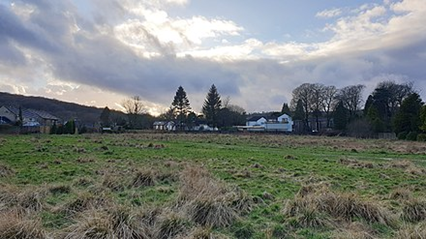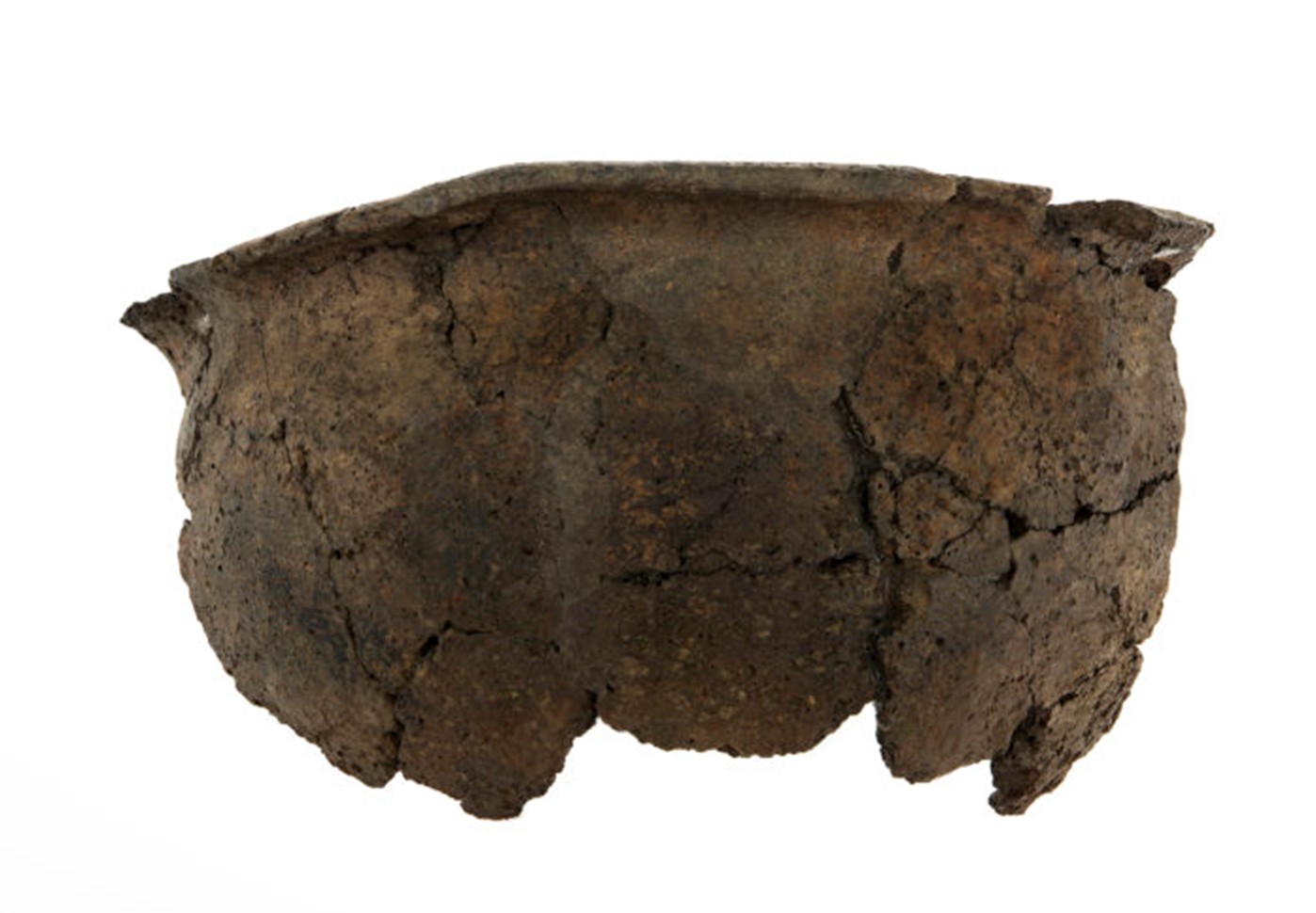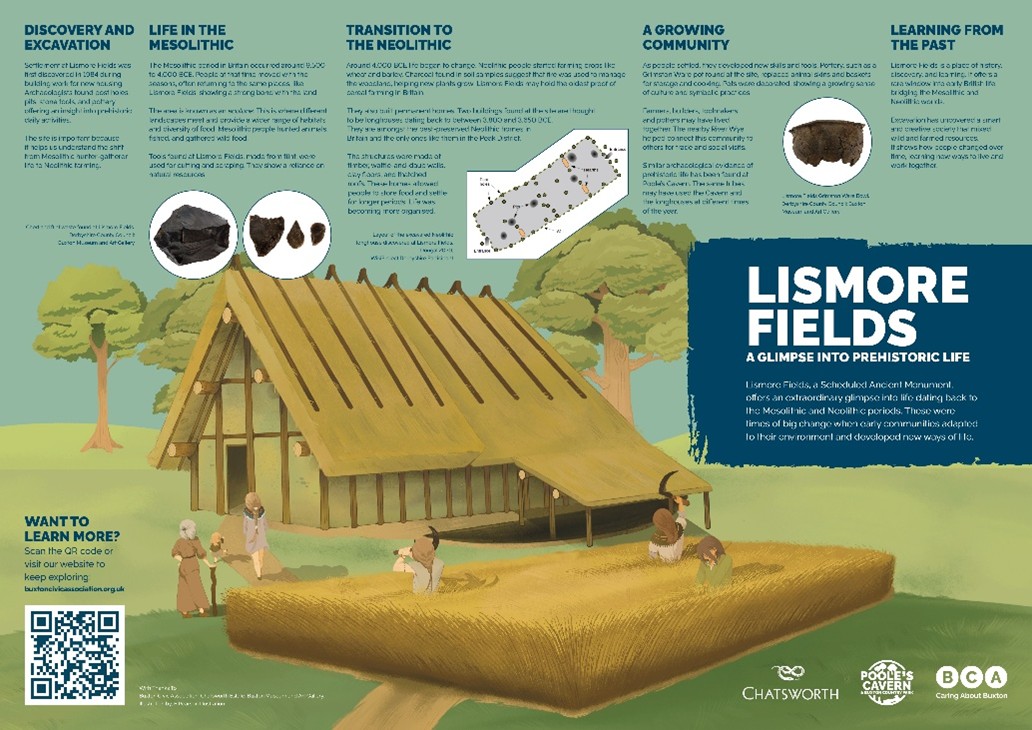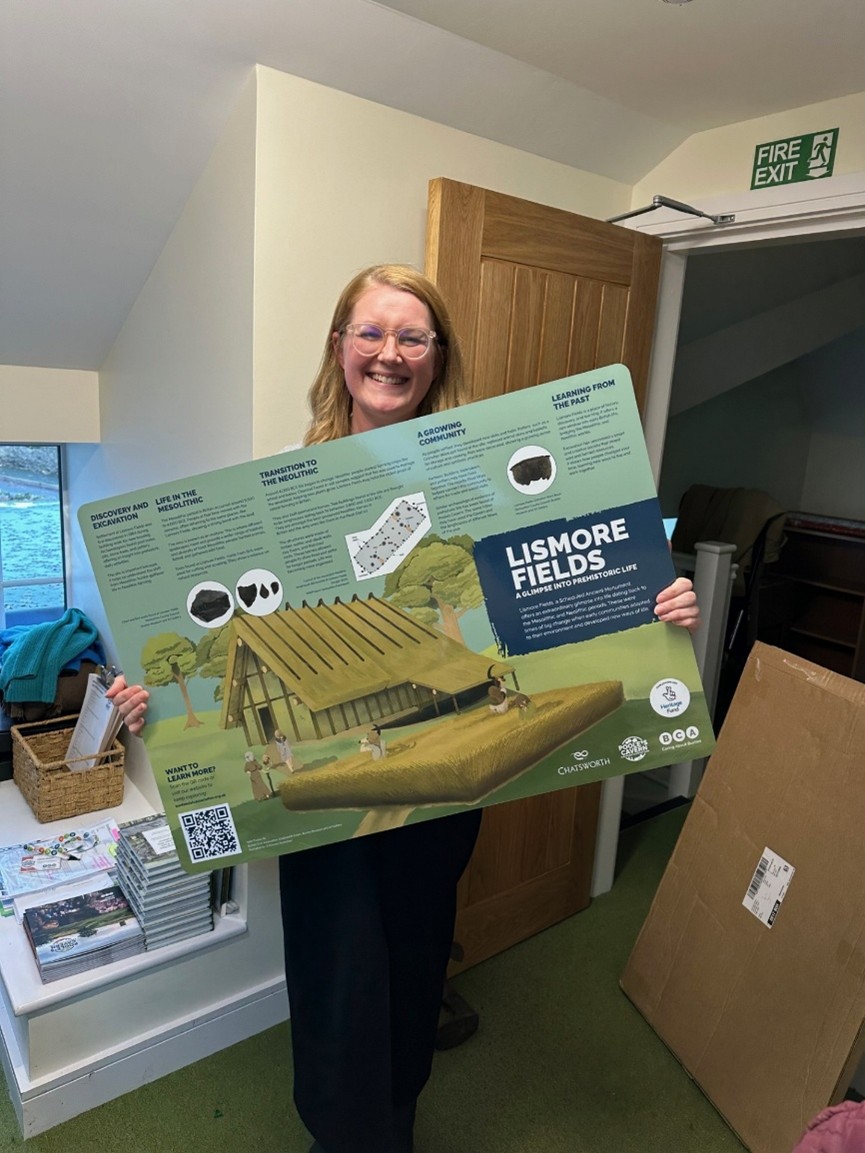
A New Window into the Past at Lismore Fields, Buxton
Thursday 11th December 2025
I am delighted to share that a brand-new interpretation panel will shortly be installed at Lismore Fields, offering residents and visitors a fascinating glimpse into Buxton’s prehistoric past.
Lismore Fields is one of the most important archaeological sites in the Peak District – a Scheduled Ancient Monument that reveals how people lived thousands of years ago, back to the Mesolithic and Neolithic periods – including what may be the earliest evidence of cereal cultivation in the British Isles.
The new panel brings these discoveries to life, sharing the story of how our ancestors transitioned from a nomadic hunter-gatherer lifestyle to a more settled farming community. The installation is part of BCA’s ongoing efforts to make Buxton’s rich heritage accessible to all. Dia and Jon White, two of the first Volunteers to work on the project have kindly written a piece to share how it all began!
If you would like any more information on the Lismore Fields Project, or to get involved in the Heritage of Poole’s Cavern and Buxton Country park, please get in touch.
Rachael, Transition Project Manager


Lismore Field: a Special Place deserves a Special Sign by Dia and Jon White
We were walking from St John’s Road through to Lismore Road when we became aware that the field across which we were walking was potentially ripe for development but, mysteriously, appeared to have never been built on.
After a little research we found that this is a very special field and has gained considerable attention from archaeologists. However, despite being a national treasure the only directions we could find to it were a footnote on a street-map of the Serpentine at the end of Burlington Road.
“Not good enough!” “It needs an Interpretation board!!”
It emerged that The Trent and Peak Archaeological Trust were searching for a Roman road close to the river Wye in 1984. Evidence of human activity soon was discovered, leading to an investigation using Pollen Grain Analysis (Wiltshire, 1986). The ancient settlement at Lismore Fields (Historic England Scheduled Monument 1007019) is now known to date to the Mesolithic period, also known as the Middle Stone Age, which in Britain commenced about 8000 BP.
Why did we not know this?
We went on to learn that a Mesolithic flint industry was present on the site at Lismore Field along with a Grimston ware pot containing the charred remains of cooking.
These ancient Buxtonians were developing from hunter-gatherers to farmers. (Clay, 2001) Lismore Field remains one of the earliest cereal cultivation sites discovered in Britain and it is right on our doorstep.
The development of Lismore Field is further supported by the discovery of the structural remains of a Mesolithic timber roundhouse and contains post holes indicating the position of a Neolithic longhouse. Perhaps then, as now, cooking brings people together and the use of cereals, herbs and spices allowed new foods to be developed. Davies (2016) suggests that the impact of the Lismore longhouses was extensive, with the river Wye being an arterial route across the region. The longhouses could have been a useful stopping off point, allowing the exchange of news, ideas and even wedding planning. This was a safe place and space in which to do business, just as Buxton is today.
The unexplored riches of the Lismore Field provide a tantalising glimpse of the lives of ancient peoples and how they developed. Buxton Civic Association hopes that the story of this field can now be re-told – a special place which deserves to be celebrated by an interpretation panel for all to see.


References and Source Material
Brown A. (2007) Dating the onset of cereal cultivation in Britain and Ireland
Antiquity 81 (2007): 1042–1052
Bradley, R. (2003) Neolithic Expectations in Armit, I., Murphy, E., Nelis, E. and Simpson, E. (eds) Neolithic Settlement in Ireland and Western Britain p 218 -220, Oxford: Oxbow
Canti, M. (1987) Soil Report on Lismore Field Ancient Monuments Laboratory, Report 216 / 87, p 1
Clay, P. (2001) An Archaeological Resource Assessment and Research Agenda for The Neolithic and Early-Middle Bronze Age of the East Midlands (PDF). University of Leicester.
Cross, S. (2003) Irish Neolithic Settlement Architecture – a reappraisal in Armit, I., Murphy, E., Nelis, E. and Simpson, E. (eds) Neolithic Settlement in Ireland and Western Britain Oxford: Oxbow p195 – 202
Darvill, T. (2008) Oxford Concise Dictionary of Archaeology, 2nd ed., Oxford University Press, Oxford and New York
Davies, S. (2009) The Early Neolithic Longhouses at Lismore Fields, Buxton: a digital landscape modelling analysis, Derbyshire Archaeological Journal Vol 129 p 1 – 16
Douglal(2020) https://upload.wikimedia.org/wikipedia/commons/2/2d/Neolithic_Longhouse_at_Lismore_Fields.png
Garton, D. (1991) Neolithic settlement in the Peak District: Perspective and Prospects, in Hodges, R. and Smith, K. (eds), Recent Developments in the Archaeology of the Peak District. Sheffield: University of Sheffield, 3-21.
Jones, G. (2000) Evaluating the importance of cultivation and collecting in Neolithic Britain’, in A. S. Fairbairn (ed) (2000), 79-84.
Nevell, M. and Redhead, N. (Eds.) (2005) Mellor: Living on the Edge. A regional study of an Iron Age and Romano-British Upland settlement. Manchester Archaeological Monographs (Volume 1)
Noble P. and Thompson A. (2009) Excavations at The Old Vicarage, Mellor, Stockport. 2009 season. Volume I. UMAU. Unpublished.
Pollard, J. (1999) These places have their moments: settlement practices in the British Neolithic in Bruck, J. and Goodman, M. (eds) Making Places in the Prehistoric World: themes in settlement archaeology : p 76 – 93 London: UCL Press
Wiltshire, P. (1991) Palynological Analysis of Lismore Fields Ancient Monuments Laboratory Report 18 / 91 p 1
Young, R. (2000) Mesolithic Lifeways Leicester Archaeology Monographs No 7, Leicester, University of Leicester Press p 179
******
Written by Dia and Jon White.
The author has made every effort to acknowledge the source material used in this review. Please contact BCA at communications@buxtoncivicassociation.org.uk in the event of errors or omissions.









